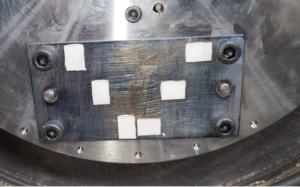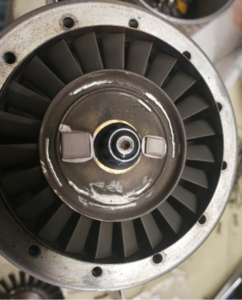
Heated Spin Rig Test Demonstrates In-Situ Bonding of Multiple Sensors, Poised to Accelerate Engine Development Cycles by Eliminating Time Routing Lengthy Cables

Instrumenting sensors on rotating test equipment is both tedious and time-consuming, adding delays to test-campaigns. Often times, testing has to be called off or tests wasted because of sensors and instrumentation not adhering to test components. Rotating components is a hard enough environment to be instrumented, adding high temperature in this mix makes it even more complicated. By utilizing proprietary high temperature bonding materials, Senastek has been able to perfect the method to bond multiple sensors at high temperatures, faster and reliably, with demonstrated success. Within a few hours multiple sensors can be bonded on to components.
Sensatek sensors were bonded to a Inconel 718 plate, representative of turbine blade material to Aerodyn for heated spin rig testing. The spin tests were performed up to 10,500 rpm, the rig maximum. The radii of the sensors on the mounted bracket resulted in g-loads up to 16,000g. Aerodyn also heated the internal spin rig environment to 350°C (662°F) during the spin tests. Sensatek’s sensor coupons remained bonded throughout the various g-loads and temperatures up to 16,000g and 350°C (662°F).
Sensatek’s proprietary bonding mechanism was also tested on a SW-140B microturbine wherein sensors stayed bonded on hub of the microturbine wheel at temperatures of 810 °C (1,490°F) and 127,000 RPM as shown in Figure below.
